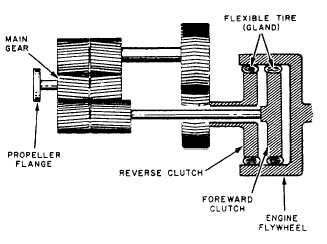or the clutch may be separate and the reverse gear
may be combined.
In most geared-drive, multiple-propeller ships,
the propulsion units are independent of each
other. An example of this type of arrangement
is shown in figure 8-7.
In some installations, the drive mechanism is
arranged so that two or more engines drive a single
propeller. This is accomplished by having the
driving gear, which is on or connected to the
crankshaft of each engine, transmit power to the
driven gear on the propeller shaft.
Friction clutches are commonly used with
smaller, high-speed engines, up to 500 horsepower
(hp). Certain friction clutches, however, in
combination with a jaw-type clutch, are used with
engines up to 1400 hp; and pneumatic clutches
with a cylindrical friction surface are used with
engines up to 2000 hp.
Friction clutches are of two general styles—
disk and band. In addition, friction clutches can
be classified as dry or wet types, depending on
whether the friction surfaces operate with or
without a lubricant. The designs of both types are
similar, except that the wet clutches require a large
friction area. The advantages of wet clutches are
smoother operation and less wear of the friction
surfaces. Wear results from slippage between the
surfaces during engagement and disengagement
and, to a certain extent, during the operation of
the mechanism. Some wet-type clutches are
periodically filled with oil. In other clutches, the
oil is a part of the engine-lubricating system and
is circulated continuously.
Twin-Disk Clutch and Gear Mechanism
One of the several types of transmissions
used by the Navy is the Gray Marine transmission
mechanism. Gray Marine high-speed diesel
engines are generally equipped with a combination
clutch and a reverse and reduction gear unit, all
contained in a single housing at the after end of
the engine.
The clutch assembly of the Gray Marine
transmission mechanism is contained in the part
of the housing nearest the engine. It is a dry-type,
twin-disk clutch with two driving disks. Each disk
is connected through shafting to a separate
reduction gear train in the after part of the
housing. One disk and reduction train is for
reverse rotation of the shaft and propeller, and
the other disk and reduction train is for forward
rotation.
Figure 8-8.—Diagram of airflex clutch and reverse-reduction
gear.
Airflex Clutch and Gear Assembly
On the larger diesel-propelled ships, the clutch,
reverse, and reduction gear unit has to transmit
an enormous amount of power. To maintain the
weight and size of the mechanism as low as
possible, special clutches have been designed for
large diesel installations. One of these is the airflex
clutch and gear assembly used with engines on
LSTs.
A typical airflex clutch and gear assembly for
ahead and astern rotation is shown in figure 8-8.
There are two clutches, one for forward rotation
and one for reverse rotation. The clutches, bolted
to the engine flywheel, rotate at all times with
the engine at engine speed. Each clutch has a
flexible tire (or gland) on the inner side of a steel
shell. Before the tires are inflated, they will rotate
out of contact with the drums, which are keyed
to the forward and reverse drive shafts. When air
under pressure (100 psi) is sent into one of the
tires, the inside diameter of the clutch decreases.
This causes the friction blocks on the inner tire
surface to come in contact with the clutch drum,
locking the drive shaft with the engine.
Hydraulic Clutches or Couplings
The fluid clutch (coupling) is widely used on
Navy ships. The use of a hydraulic coupling
eliminates the need for a mechanical connection
between the engine and the reduction gears.
Couplings of this type operate with a small
amount of slippage.
8-7


